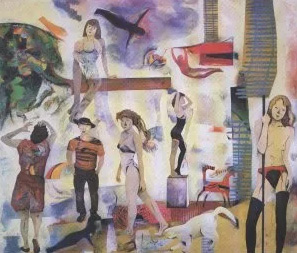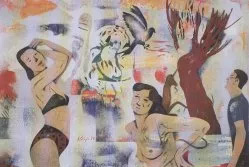"Master of colour humanism" 2000
I must write about Anna Ziaja's art as I if were describing a very familiar world, almost one of my own for I have long loved her painting, admired it and traced the ways of its development, transformations, evolution of style, and the new meanings that have sunk into it. It may seem that the painter has shown the same themes for years: a cosmos of her own inhabited by people and animals. But that world, just like the one around us, has been changing ,so much. It changes maintaining its uniqueness, individuality and privacy, standing out at a glance. Very rarely has this feature been found in modern painting.
Anna Ziaja's pictures are figurative, poetic, full of personal lyricism, melancholy, and sometimes bitter reflectiveness. With all their aesthetic and artistic merits they remain deeply psychological, speaking of people's lots, showing the world through the whole gamut of individuals with complex personalities, as well as with banal ones, but still entangled in absurd actions of everyday life.
The protagonists of these pictures, disguised as clowns or mannequins, are, in fact, clowns and mannequins. They cross each other, execute some results and skips, use accessories ,such as rotating hoops, flying traps, stretched tightropes, tautened skipping ropes; they perform learned exercises and go away, they pass away together with their temporary successes. This oneirich circus becomes a great metaphor: expressively terse and extremely accurate synthesis of life in Anna Ziaja's painting shows our everyday arena.

Pesimistic messages contained in her works (as one might infer from the above description) are inscribed in an optimistic form and mood, making the impression of a smile seen through a veil of tears. The people presented are not happy. They all play their roles on the same stage but do not develop deeper relationships. It seems that they make up different subplots of a huge novel that do not, however, imperf with each other. This is why those frequently overpopulated landscapes accommodate so much loneliness his this multitude of plots that constitutes the unique melodiousness of Anna Ziaja's painting because this world of people passing by each other is woven from highly polyphonic, complimentary fibres (having in mind the Renaissance polyphony in which consonance is superior to logier of form) for so many irrational notes resonate here.

The relationships between the characters from Anna Ziaja's pictures bring to my mind also some of Józef Szajna's plays in which people do not inquire themselves into the others' tragedies because each of them recites only monologues that are not responded to by their stage companions. The tragedy then consists in the lack of communication, probably a greater disaster than an open conflict.
In those relationships there ran be found some specific chastity, even virginity of interpersonal references, but there is also a chill of indifference. Who knows, perhaps it is this lofty attitude to passing reactions that fails to march Anna Ziaja's painting with current, fleeing moments and adds to its timeless quality.

Viewer's eye is attracted by bold, mellow hues. Anna Ziaja indulges in using pure, vivid colours, but at the same time combines them with toned down, mixed, untypical ones, applying surface quality contrasts: mat - lustre. The colour, which is closely connected with the objects, fragments of landscapes, protagonists garments, sometimes seems to release itself and explode abvore reality, assuming the shape of colourful smoke or clouds. full of thick fluorescence similar to the one given off by fireworks. It may look like some l superabundance of affection, which, unused by indifferent souls of this world's inhabitants, liberates itself and hoovers above them, l goring colour to their existence, as if the painter were sowing the completeness of her own affection over an imperfect and a bit unhappy world.
The second important characteristic of Anna Ziaja's painting is her unique experimenting with space. The artist breaks and thins it do? in a mysterious and magical way. ft is a sort of examining the consistency of the world which people thicken with their parities and animosities, egoism, aggression and indifference. The broken planes, changed proportions of figures, distorted perspectives, human shapes levitating above the ground, different rations of fiat silhouettes to their mass, weight, and gravitation lead to the scenes shown in the pictures with their own, original logier, clearly deliberate and subordinate to the subject and expression. This sometimes produces the impression that the air is the central character in those canvases. In it it's submissive inhabitants float like playthings. Similarly, the patches of liberated hues, those delicate mists of colour, serve disturbing the homogeneity of space, inciting unrest from the verge of fairy confabulation.

With such an approach to art certain synthetic ism of contents, of the world, and also of human silhouette and mime becomes lanced by the richness and diversity of forms, lines, shapes, and colours leading to this first impression - psychologist of impression, and to the next impression - complex artistic form focusing on technical aspects.
Personally, however, l am convinced that Anna Ziaja will never come to pure colour-format abstract painting; otherwise she would have to give up humanism and stop thinking about man that has always been so dear to her.
TŁUMACZENIE: Aleksander Rzyman
GALERIA BWA JELENIA GÓRA 1995


